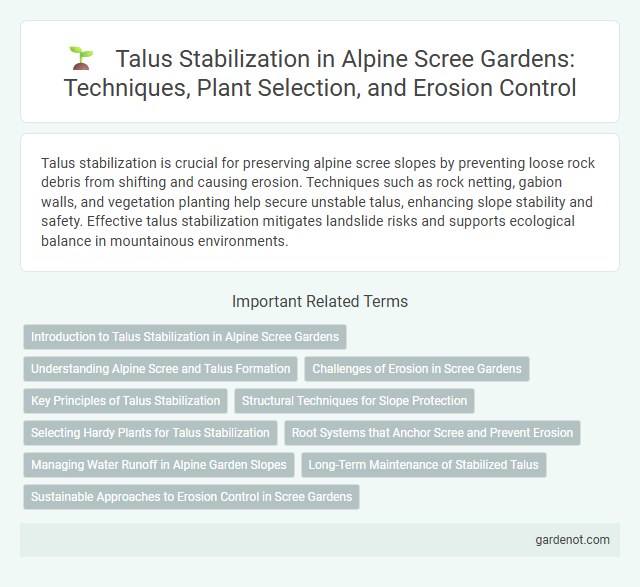Talus stabilization is crucial for preserving alpine scree slopes by preventing loose rock debris from shifting and causing erosion. Techniques such as rock netting, gabion walls, and vegetation planting help secure unstable talus, enhancing slope stability and safety. Effective talus stabilization mitigates landslide risks and supports ecological balance in mountainous environments.
Introduction to Talus Stabilization in Alpine Scree Gardens
Talus stabilization in alpine scree gardens involves techniques to prevent soil erosion and rock displacement on steep, rocky slopes composed of loose stones. Effective stabilization promotes plant root anchorage and supports biodiversity by maintaining substrate integrity in harsh alpine environments. Mechanical measures such as rock netting and biological solutions like vegetation mats create durable talus slopes that mimic natural processes.
Understanding Alpine Scree and Talus Formation
Alpine scree consists of loose rock fragments that accumulate on steep mountain slopes through freeze-thaw weathering and gravity-driven processes. Talus formation occurs when rockfall deposits create unstable slopes prone to shifting and erosion, necessitating talus stabilization techniques to maintain slope integrity. Effective stabilization relies on understanding the scree's composition, grain size distribution, and dynamic behavior under environmental stress.
Challenges of Erosion in Scree Gardens
Talus stabilization in alpine scree faces significant challenges due to persistent erosion caused by freeze-thaw cycles and heavy runoff, which destabilize loose rock fragments. Implementing effective erosion control requires careful selection of native vegetation with deep root systems to anchor soil and reduce surface displacement. Additionally, engineering solutions like rock netting and terracing help maintain slope integrity while preserving natural drainage patterns crucial for scree garden ecosystems.
Key Principles of Talus Stabilization
Effective talus stabilization in alpine scree involves controlling rockfall and preventing slope erosion through strategic rock placement and vegetation establishment. Key principles include enhancing interlocking of talus blocks to increase mechanical stability, promoting root growth to reinforce soil and reduce surface displacement, and managing water drainage to prevent saturation-induced instability. These methods collectively contribute to maintaining slope integrity and minimizing hazards in high-altitude environments.
Structural Techniques for Slope Protection
Structural techniques for talus stabilization in alpine scree environments involve the installation of retaining walls, rock bolts, and wire mesh to prevent slope failure and rockfall hazards. Gabion baskets filled with angular stones and engineered crib walls provide effective erosion control by dissipating energy from falling debris and reinforcing unstable scree deposits. These methods enhance slope integrity, reduce sediment transport, and protect downstream ecosystems from sedimentation.
Selecting Hardy Plants for Talus Stabilization
Selecting hardy plants for talus stabilization involves choosing species with deep root systems that enhance soil cohesion and resist erosion on unstable alpine scree slopes. Native alpine grasses, sedges, and cushion plants such as Dryas octopetala and Silene acaulis provide effective ground cover and improve slope stability by anchoring loose rock fragments. These plants tolerate harsh conditions, including poor soil, extreme temperature fluctuations, and high wind exposure, making them ideal for long-term stabilization efforts on talus deposits.
Root Systems that Anchor Scree and Prevent Erosion
Root systems of alpine scree plants play a critical role in talus stabilization by anchoring loose rock fragments and preventing soil erosion. Deep and fibrous roots penetrate between scree deposits, creating a natural mesh that binds the talus material together. This biological reinforcement reduces sediment displacement during heavy rains and helps maintain slope integrity in mountainous environments.
Managing Water Runoff in Alpine Garden Slopes
Talus stabilization in alpine garden slopes requires efficient management of water runoff to prevent soil erosion and slope failure. Incorporating drainage systems such as French drains and contour trenches helps redirect water flow away from unstable scree deposits. Vegetation with deep root systems, like alpine sedges and grasses, enhances soil cohesion and promotes water infiltration, reducing surface runoff impact.
Long-Term Maintenance of Stabilized Talus
Long-term maintenance of stabilized talus requires consistent monitoring of rockfall activity and vegetation health to ensure slope stability. Implementing erosion control measures and periodic reinforcement of retaining structures helps mitigate displacement and surface degradation over time. Data from remote sensing technologies and geotechnical sensors provide critical insights for timely interventions and adaptive management of alpine scree environments.
Sustainable Approaches to Erosion Control in Scree Gardens
Talus stabilization in alpine scree environments employs sustainable erosion control techniques such as bioengineering with native vegetation to enhance root reinforcement and soil retention. Incorporating coir mats and geotextiles supports gradual sediment settlement while preserving natural drainage patterns. These approaches reduce sediment runoff and maintain ecological balance, crucial for long-term stability in scree gardens.
Talus stabilization Infographic

 gardenot.com
gardenot.com